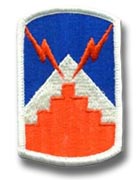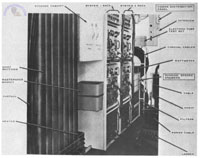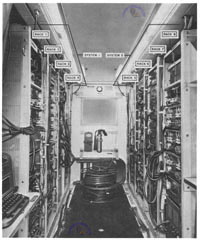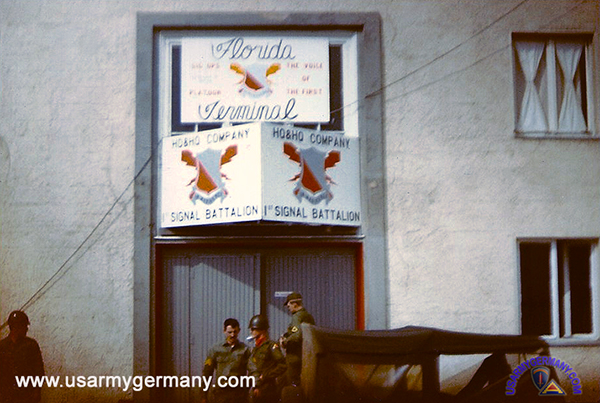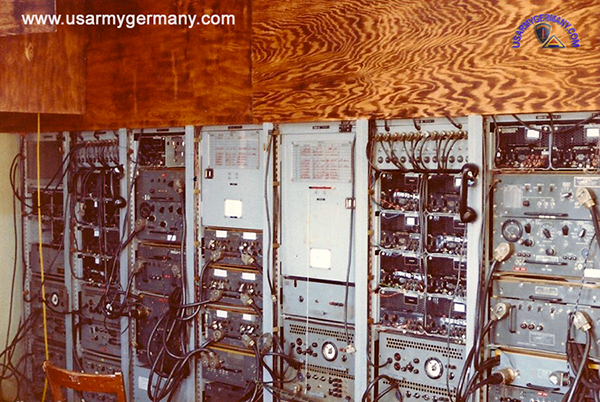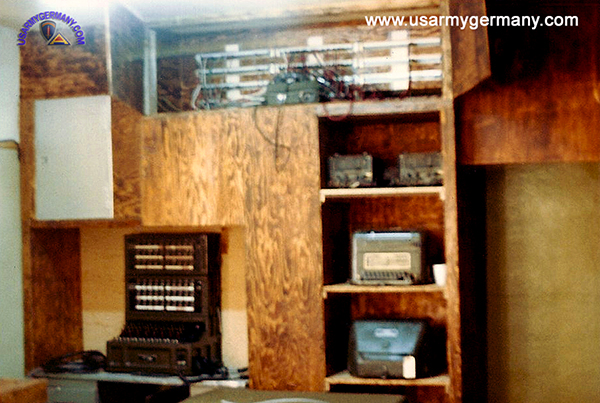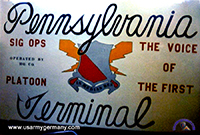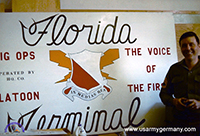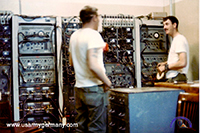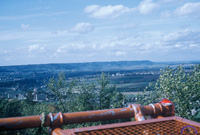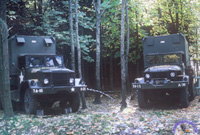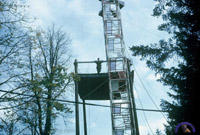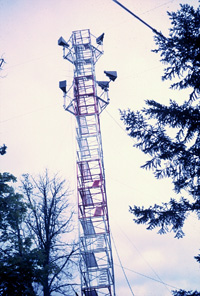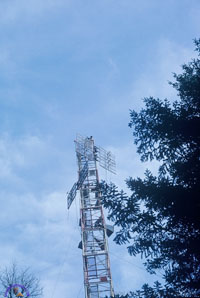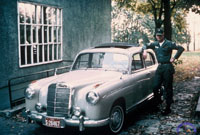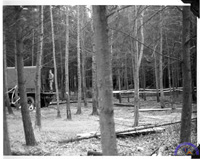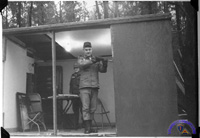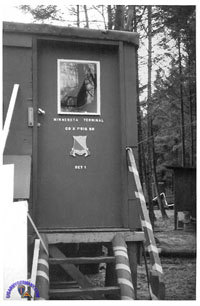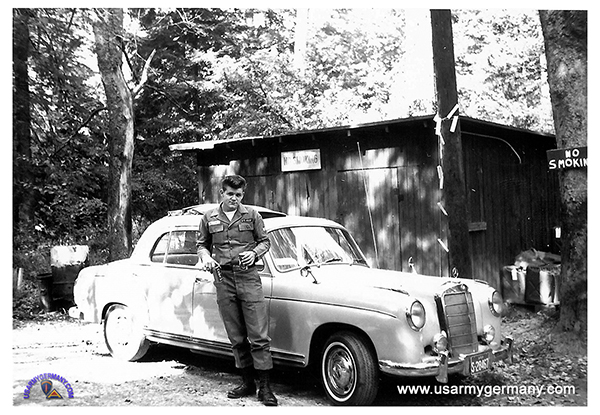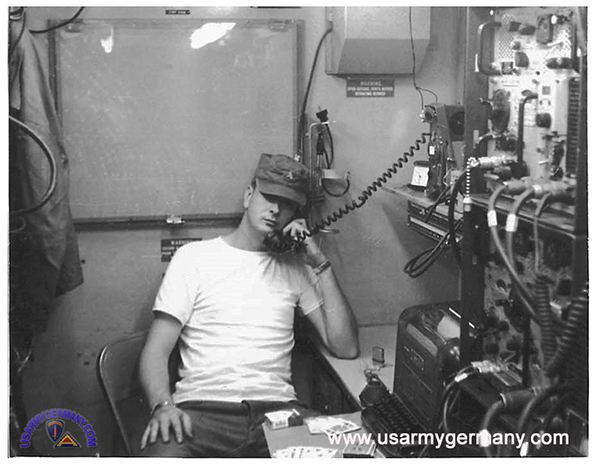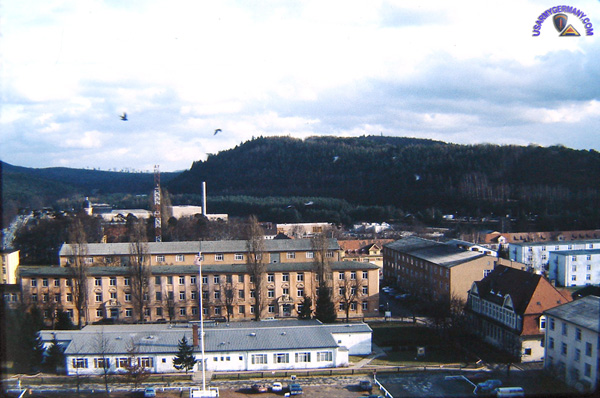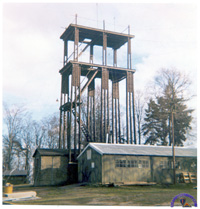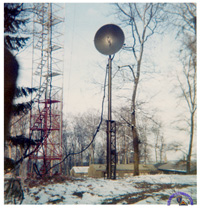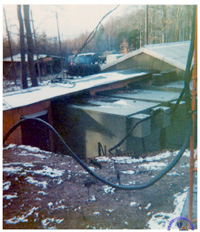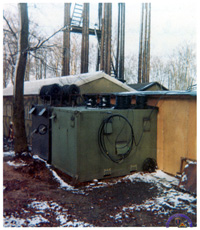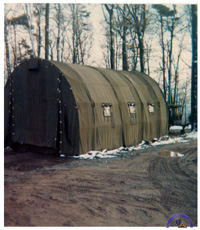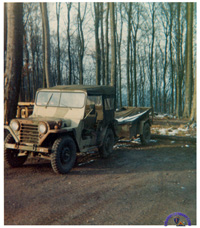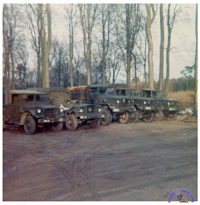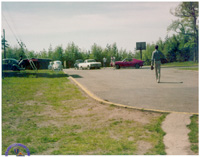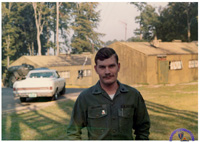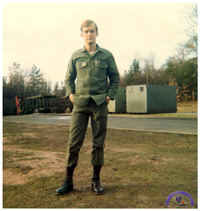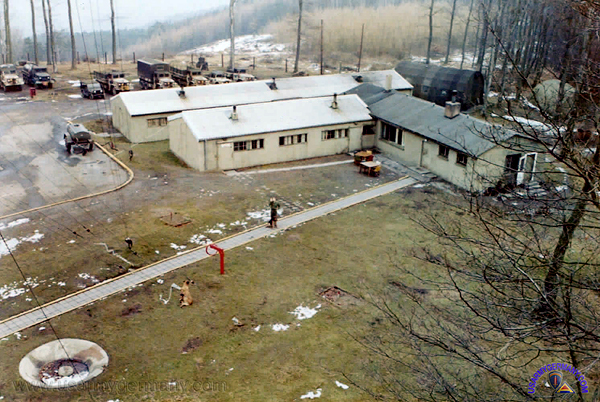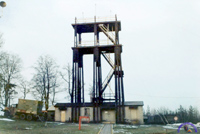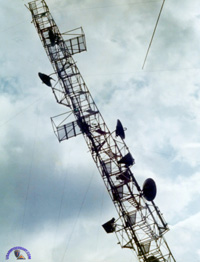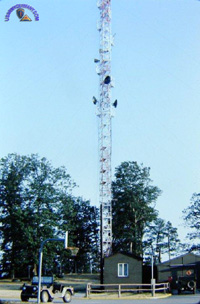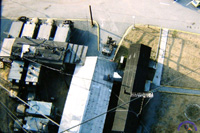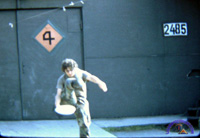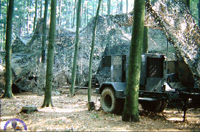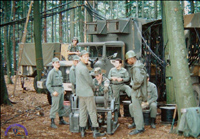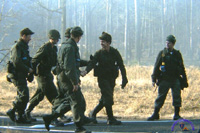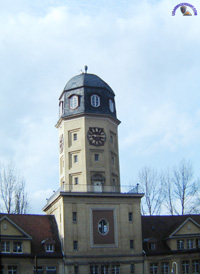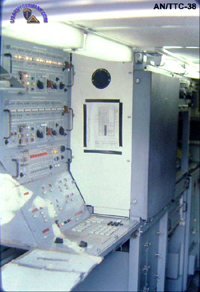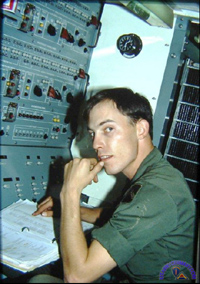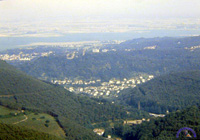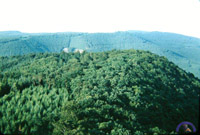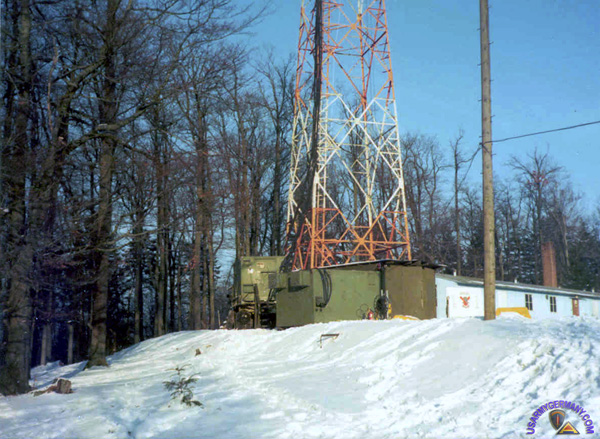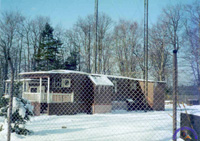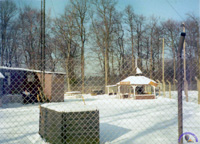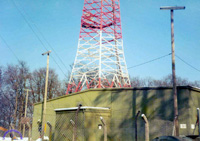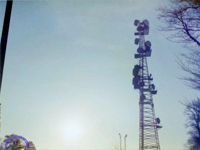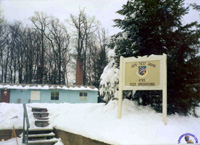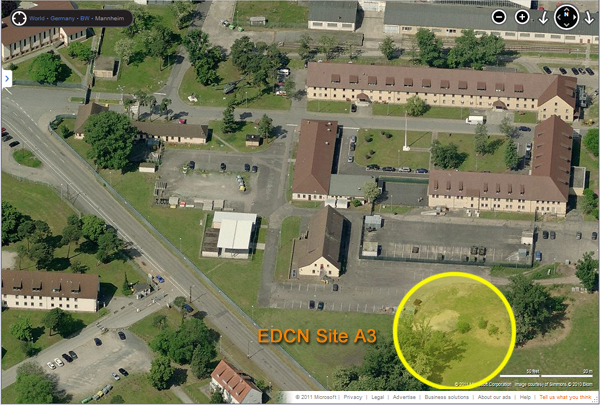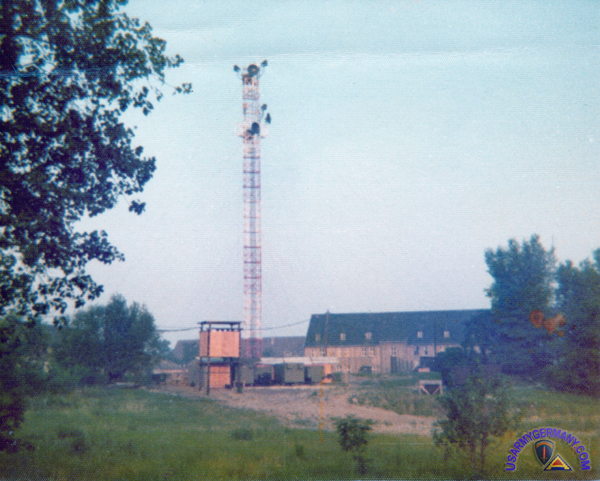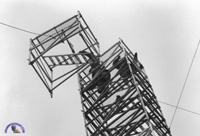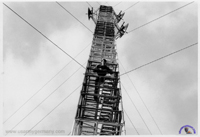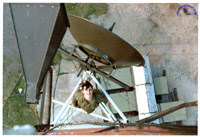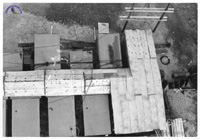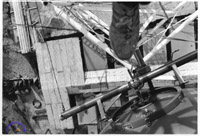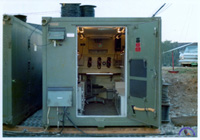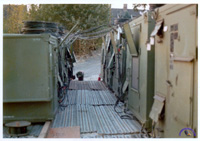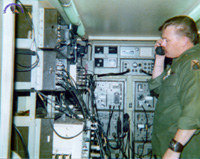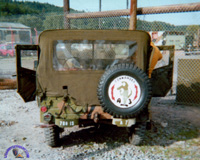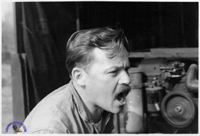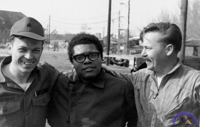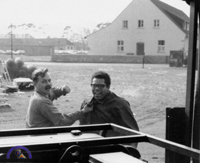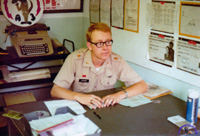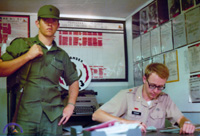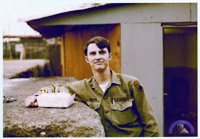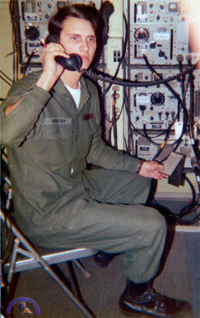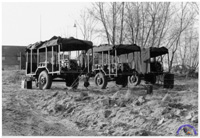| If you do NOT see the Table of Contents frame to the left of this page, then Click here to open 'USArmyGermany' frameset |
||||||||||||||||||||||||||||||||||||||||||||||||||||||||||||||||||||||||
1st Signal Battalion |
||||||||||||||||||||||||||||||||||||||||||||||||||||||||||||||||||||||||
|
||||||||||||||||||||||||||||||||||||||||||||||||||||||||||||||||||||||||
| Battalion History | ||||||||||||||||||||||||||||||||||||||||||||||||||||||||||||||||||||||||
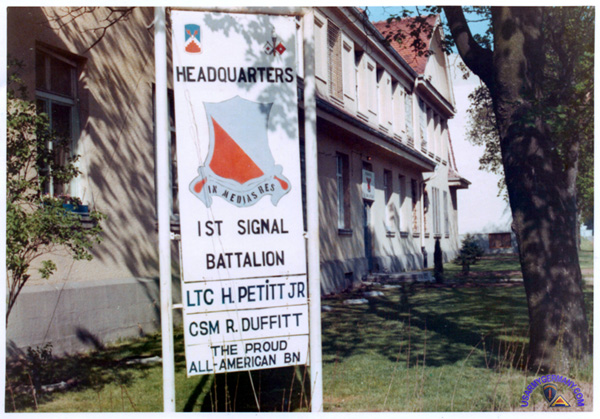 1st Signal Battalion headquarters, c. 1973 (Chuck Webster) |
||||||||||||||||||||||||||||||||||||||||||||||||||||||||||||||||||||||||
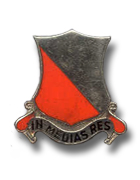 1st Signal Battalion DUI 1st Signal Battalion DUI |
||||||||||||||||||||||||||||||||||||||||||||||||||||||||||||||||||||||||
1st Signal Bn (Combat Area) (HHC, A, B, C & D Companies) was activated at Panzer Kaserne in Böblingen, Germany on 1 October 1961. |
||||||||||||||||||||||||||||||||||||||||||||||||||||||||||||||||||||||||
| 1963 | ||||||||||||||||||||||||||||||||||||||||||||||||||||||||||||||||||||||||
| (Source: Email from Bob Drapeau, B Co and "Jump" Pltn, Hq Co, 1963-65) | ||||||||||||||||||||||||||||||||||||||||||||||||||||||||||||||||||||||||
I was assigned to the 1st Signal Battalion at Panzer Kaserne, Boeblingen from April 1963 to September 1965. I was assigned to B Company as a Carrier Platoon and Radio Platoon Leader, and then moved to Headquarters Company as the "Jump" Platoon Leader and Company Commander.
HQ, B, C and D Companies were at Panzer Kaserne - Boeblingen. A Company, 1st Signal Bn was in Karlsruhe and we picked up A Company, 26th Signal which was in Ludwigsburg - 6 Companies = 5 AASC and Jump
I had the shot from Army Main to the First French Army in Rastatt (I speak French) and the Army shot to VII Corps in the field. In wartime, 1st Signal provided five AASCs and a "jump" capability - In peacetime, the Battalion participated primarily in training activities. We had some limited garrison signal requirements. In peacetime, we did not have any skeleton AASCs in place - when we went to the field we normally went to the same places but we did not maintain any permanent sites there.
The circuits from 7th Army Main to 1st French Army were routed through (as I recall) a couple of AASCs then to Rastatt. As I recall the 1st Signal unit at the Konigshof (Webmaster: Koenigstuhl?) overlooking Heidelberg - I believe it was C Company (with HQ Company co-located) had the shot to Rastatt. I don't remember if any relays were involved.
I had a MRC-54 (3 GRC-50s) and a MCC-6 (2 ea AN/TCC 7) - plenty of spare equipment. I terminated the shot in the carrier rig and the French took the circuits to their comm center. We lived with the French on their kaserne and traded parts of our "C" rations for their wine. The shot to VII Corps was from Company B to VII Corps Main - a direct shot - no relays - we terminated it with a MRC-54 and a MCC-6 - the circuits again were routed through a couple of AASCs. The mission of the 1st Sig Bn in wartime was to provide area signal centers in the rear of VII Corps.
Our prime mission in garrison was training and maintenance - test shots were conducted on a regular basis - an aside - the Battalion never passed CMMI inspections on vehicles because the trucks were coded yellow because of age!
In peacetime, there were some remote sites supported by the Battalion. I believe they were assigned to C and D Companies. |
||||||||||||||||||||||||||||||||||||||||||||||||||||||||||||||||||||||||
|
||||||||||||||||||||||||||||||||||||||||||||||||||||||||||||||||||||||||
| 1972 | ||||||||||||||||||||||||||||||||||||||||||||||||||||||||||||||||||||||||
| (Source: Email from B. Cano, Det #1, 1972-74) | ||||||||||||||||||||||||||||||||||||||||||||||||||||||||||||||||||||||||
| I was just reading about 1st Signal Battalion on Wikipedia. I was stationed there in Ktown from November 1972 to April 1974. We were assigned to HHC 1st Signal Battalion Detachment #1. I don't have pictures of the equipment used - pics were not allowed. My unit had 28 enlisted people and 3 NCO's - one Sp/8 and two Sp/7's - till just about the time I left, then we started to integrate with HHC. The equipment we had was not on 2 1/2 trucks but on 2 18-foot trailers. If not mistaken the initials were DSTE. ADDITIONAL INFORMATION We were stationed at Kleber Kaserne. We were a mobile communication center (2 semi-trailers w/ DSTE equipment). Our equipment NEVER went live. Spent 17 months with it but not once was a message received or sent. When in the field we had to set up our own site separate from others. We had our own perimeter w/ concertina wire; our own guard w/ live rounds - if not on our list, "NO ONE" could enter. We were attached to HHC 1st Signal but we did not really answer to anyone. We were all 72F20 Data Communications Terminal Specialist (last time checked think MOS still active). 3 of us (I was one) were sent to Darmstadt (440th Signal Bn) (twice) on TDY to work at their comm ctr (3 wks ea time) but never got to work . Their excuse was about clearance (we all had TS) . We did 2 field exercises in 1973 (1 US and 1 US/German Army). 3 of us were sent to Zweibrucken to work their fixed comm ctr (for 2 months) . Sorry, can't remember the Company designation I was with, do remember they had the STRATCOM patch. (Webmaster note: maybe the 327th Signal Company?). In 1973 we were put on 24 hr alert due to Israel prob (squads had different times). We seemed to be always on alert. I must say I enjoyed my time in the military very much. Would do again. The unit I was in - from what I remember - was suposed to go VN but since peace talks were ongoing orders were changed . Never got confirmtion on that but my senior NCO kind of hinted. . Hope this helps. |
||||||||||||||||||||||||||||||||||||||||||||||||||||||||||||||||||||||||
| If you have more information on the history or organization of the 1st Signal Battalion, please contact me |
||||||||||||||||||||||||||||||||||||||||||||||||||||||||||||||||||||||||
| Florida Terminal - Site 00 (Kaiserslautern) | ||||||||||||||||||||||||||||||||||||||||||||||||||||||||||||||||||||||||
| (Source: Email from Gary L. Estler) | ||||||||||||||||||||||||||||||||||||||||||||||||||||||||||||||||||||||||
| I was assigned to HHC, 1st Signal Battalion in December, 1970. At that time, the Battalion and its four line Companies were based in Kapaun Barracks, Kaiserslautern, Federal Republic of Germany. LTC Overdahl was the Battalion Commander at the time, followed by LTC Leon Zimmer during my tour. HHC Company Commander was CPT Mike Ward.
The compound also housed a Transportation Group and part of the 32d Army Air Defense Command. Sometime after my departure, the compound was turned over to the Air Force and became Kapaun Air Station. My initial assignment was as the HHC Signal Operations Platoon Leader with SFC Bryan Dawson as my Platoon Sergeant. Later I was moved to the position of Battalion Radio Officer in the Battalion S3 shop. The Sig Ops Platoon was required to operate the Battalion’s tactical communications terminal (Florida Terminal) 24/7. In order to make staffing and maintenance of the more efficient and requiring fewer resources, we dismounted our AN/TCC-7 and SB-86 switchboard assemblages and built them into a room on the top floor of the building in which the Battalion HHC was located. My Platoon originally had a radio terminal on a mountain behind the barracks from which we ran cable down to the mux terminal. That split terminal was called “Pennsylvania Terminal” with a 00 (zero-zero) designation. For reasons I don’t recall, the name was later changed to “Florida Terminal.” The terminal included two AN/TTC-7 multiplex racks and an SB-86 switchboard that was designated “Ceramic” in the 7th Signal Brigade network. We had a Radio-Wire Integration interface tied into the switchboard. I believe the radio relay assemblage included three AN/TRC-24 radios. I left the Battalion in January, 1971 after my request for an intra-theater transfer to the Republic of Vietnam was approved. Thanks for bringing back many good memories. |
||||||||||||||||||||||||||||||||||||||||||||||||||||||||||||||||||||||||
| Einkorn | ||||||||||||||||||||||||||||||||||||||||||||||||||||||||||||||||||||||||
| (Source: Email from Denton Aylor) | ||||||||||||||||||||||||||||||||||||||||||||||||||||||||||||||||||||||||
These pictures came from Daniel McMunn, now retired 1st Sgt and in his 70's. These pictures are from the 1964/65 period. I was Dan's room mate for over a year before being promoted to Sgt. in late 1965. He just sent these pictures to me. |
||||||||||||||||||||||||||||||||||||||||||||||||||||||||||||||||||||||||
| ADDITIONAL PHOTOS | ||||||||||||||||||||||||||||||||||||||||||||||||||||||||||||||||||||||||
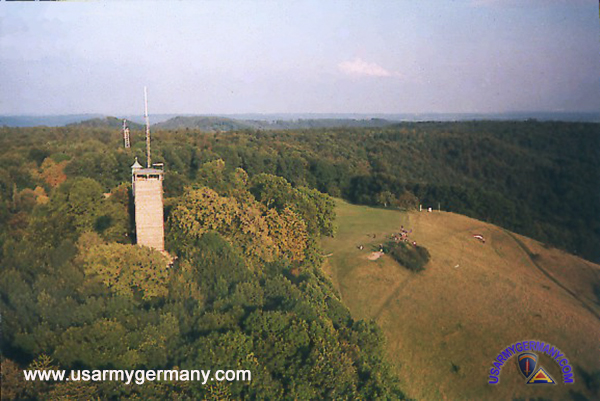 The Einkorn tower (front) and the 1st Sig and 34 Sig tower in the rear (Denton Aylor) |
||||||||||||||||||||||||||||||||||||||||||||||||||||||||||||||||||||||||
| Hardenburg | ||||||||||||||||||||||||||||||||||||||||||||||||||||||||||||||||||||||||
| 1973 | ||||||||||||||||||||||||||||||||||||||||||||||||||||||||||||||||||||||||
| (Source: Email from John Anderson, A Company, 1st Signal Bn, 1973-75) | ||||||||||||||||||||||||||||||||||||||||||||||||||||||||||||||||||||||||
|
||||||||||||||||||||||||||||||||||||||||||||||||||||||||||||||||||||||||
| 1974 | ||||||||||||||||||||||||||||||||||||||||||||||||||||||||||||||||||||||||
| (Source: Email from Mike Evans, 1974-76) | ||||||||||||||||||||||||||||||||||||||||||||||||||||||||||||||||||||||||
| I was stationed at Site 09 near Hardenburg from 1974-1976. I have included some pictures that you are free to post on your site if you wish. In the first picture it shows the operations building and wood tower on site 09. The second picture shows the antenna tower on site 09. And last the third picture (above) shows the site mess building on the right, the day room on the left and the barracks at the top all viewed from the wooden tower. Texas 09 was operated by A Co, 1st Signal Bn while I was there. I can remember John Peterson. And I have just been reminded by my old friend, Ron Hochstetler, that we had maintained signal to other sites such as 101 in K-Town and I think it was A3 in Mannheim which was also operated by A Co. |
||||||||||||||||||||||||||||||||||||||||||||||||||||||||||||||||||||||||
|
||||||||||||||||||||||||||||||||||||||||||||||||||||||||||||||||||||||||
| 1975 | ||||||||||||||||||||||||||||||||||||||||||||||||||||||||||||||||||||||||
| (Source: Email from Ron "Hock" Hochstetler) | ||||||||||||||||||||||||||||||||||||||||||||||||||||||||||||||||||||||||
| "The Hill," Durkheim Although not part of the "Mainstream" of 1st Signal Battalion, "The Hill" was a major happening in the lives of the crew that served there. "The Hill" was on a remote hilltop just west of Bad Durkheim. Yes, the "Bad D" where Wurstmarkt (the big winefest) was held every September. The site (I am told) was activated in the 1960s and underwent several name changes: Hawaii, Texas 09, Site 09, and Site 46 up to it’s termination in the 1980’s. When I got on site in December 1975 it was Site 09 and part of the Emergency Deployment Communications Network (EDCN). Most people in K-Town knew The Hill as it related to the REFORGER, CREASTED EAGLE, and WINTEX exercises but for those of us stationed up there it was much more. The friendships and bonding that took place there were life long. We worked a 9/3 schedule: 3 days of maintenance shift (8 hours), 3 day shifts (12 hours), 3 night shifts (12 hours), then 3 days off. Three days off wasn’t too bad but coming off a 12 hour nightshift you spent half of your first day off catching up on sleep! We maintained 5 multichannel systems, patch panel, telephone switch, and RWI systems 24hours a day, 365 days a year. On top of that we installed additional systems for the major exercises, many of which were augmented by "Mainstream" folks from Kleber The biggest "past-time" on the The Hill was the Cabin. The Cabin was a little log cabin that sat on the edge of a cliff about 10 minutes walk west of the site perimeter. I’m sure most that were ever on site made the trip out to the cabin for a little (or A LOT) of "extracurricular activity"! ~evil grin~ Those that did, know what I’m grinning about! At the risk of overlooking people and hurting some feelings, I will attempt to list as many people as I can recall during my stay on The Hill from 75-79: |
||||||||||||||||||||||||||||||||||||||||||||||||||||||||||||||||||||||||
|
||||||||||||||||||||||||||||||||||||||||||||||||||||||||||||||||||||||||
| I retired out of the Army here in Germany and live about 20 minutes due south of Bad Durkheim in Neustadt. If there is anything anyone would like a current picture of please let me know. I would enjoy hearing from anyone that has any stories or pictures from the Hill or Bad Durkheim. Regards, Ron "HOCK" Hochstetler A Co, 1st Circus, "The Hill" Bad Durkheim, 75-79 |
||||||||||||||||||||||||||||||||||||||||||||||||||||||||||||||||||||||||
| 1983 | ||||||||||||||||||||||||||||||||||||||||||||||||||||||||||||||||||||||||
| (Source: Email from Ed Hawks) | ||||||||||||||||||||||||||||||||||||||||||||||||||||||||||||||||||||||||
| Site about 15 miles west of Mannheim: I was only filling in there temporarily. Really neat site though. I loved working there. As the crow files I am certain it was only about 15 miles west of Mannheim. It was one of those semi-permanent sites. The people that worked there had a small orderly room, day room and mess hall. I don't think there were more than 20 people there at any given time. Based on my memory, Bing maps and these photos I would have to be Hardenburg ( Our Battalion got tapped for a few people to support them during leaves and such. They had some crude buildings there with sleeping quarters and a day room. We had to bring our tent to sleep in. That Hardenberg site was what I would refer to as a semi permanent. It had buildings and sleeping quarters. The rigs you see were all backed up into a permanent structure. This is really a stretch for my memory but if you recall there was a system called AUTOVON. My memory was that this was the system in place if the AUTOVON system crashed. We still used the tactical phone switches but in a permanent capacity. When I went to 17th Sig in Hoechst just outside of Frankfurt one of our compaines operated a similiar facility just in back of the Abrahms building for V Corps. That is when Colin Powell was V Corps commander. They used to call it "The Patio" because the equipment literally sat on a patio out back. Site 01 (Kaiserslautern): 01 was the site we always went to at C Co. Best I can tell it was at Johaniskreuz (south of Kaiserslautern). Site 01 was the woods. No facilities. 1st Signal was a tactical company period. We always deployed to the woods. The tower was set up towards the center top of this image and although the resolution is not too great I still think I can see the permenant tower that was there at the time. The carrier and microwave vans were up there. We were down the hill about 1000 feet to the southwest. Patch, switch and mess hall. This was not a fixed site. Only used to support major excercises such as REFORGER and WINTEX. When I was at 17th Sig, they ran a sissy outfit. Most of my "deployments" were to parking lots with circus tents errected by contractors for us to sleep in. We rarely slept in an Army tent there. Site west of Darmstadt: It was near Neunkirchen and I tried to center the field site in the middle of this link. It was the hightest peak in the area. There had been some occasions when the 440th AN/TTC-38 had crashed and they needed us to go there. I don't remember then number of that site but will try to find out. When I find out the numbers of all these sites I will lable them appropriately in my Facebook photos. |
||||||||||||||||||||||||||||||||||||||||||||||||||||||||||||||||||||||||
|
||||||||||||||||||||||||||||||||||||||||||||||||||||||||||||||||||||||||
| Langerkopf | ||||||||||||||||||||||||||||||||||||||||||||||||||||||||||||||||||||||||
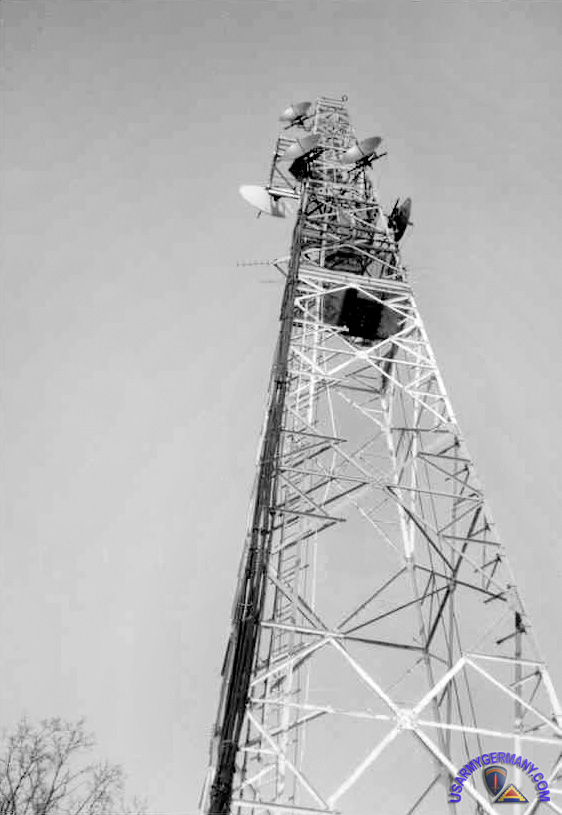 Site 101 antenna tower, Langerkopf |
||||||||||||||||||||||||||||||||||||||||||||||||||||||||||||||||||||||||
| (Source: Email from Mark Cowles) | ||||||||||||||||||||||||||||||||||||||||||||||||||||||||||||||||||||||||
| I can remember the EDCN site designations: | ||||||||||||||||||||||||||||||||||||||||||||||||||||||||||||||||||||||||
|
||||||||||||||||||||||||||||||||||||||||||||||||||||||||||||||||||||||||
| The EDCN site on Kleber was definitely called 00 -- I know cause I was there for most of 1975. I went to 101 right before Thanksgiving. Site 102 (on Husterhoeh Kaserne, Pirmasens) was a great site... our shelter was at the base of the microwave tower. There was an AFEES snack bar and pizza parlor less than 20 paces from the shelter door! |
||||||||||||||||||||||||||||||||||||||||||||||||||||||||||||||||||||||||
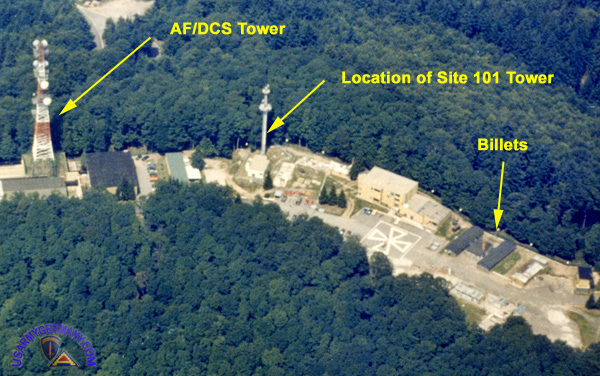 Partial view of Langerkopf Communication Station with Site 101 (Langerkopf website) |
||||||||||||||||||||||||||||||||||||||||||||||||||||||||||||||||||||||||
| The Langerkopf site was always referred to as “Site 101” during my time there. It was an Air Force site, we were allowed to share their compound. In the aerial image (above), our barracks is the “H” shaped building on the far right. I saw an image of this building as it is today, it was totally demolished. We had our own tower, it was approximately in the same location as the monopole (concrete antanna tower) in the aerial image. Our tower was only 125 feet, the Air Force tower (part of the DCS European wideband network) was about 330 feet (it is still standing today). The Air Force was very kind to us. We got to use their facilities... we got movies regularly (16mm). I ran the projector most nights. We had set up a makeshift theatre in the Air Force’s mess hall. We had our own mess in our barracks, and an army cook assigned. I recall the Bicentennial on July 4th, 1976 was very nice. The German Nationals that worked on site procured a wild boar for us and put it on a spit, we were up early to prepare the hot coals. All the wives and children visited, we ran movies for the kids, the wives brought covered dished and cakes... a very pleasant day. We had a TV antenna on our tower, we could just barely pick up AFN TV in Kaiserslautern, 25 km distant. We went to the shelter and watched live coverage via satellite of the tall ships in New York harbor. We also were following coverage of the hostage rescue in Entebbe, Uganda. I remembered something since my last email....I was at Dahn during the summer of 1974 (site U1 and Hill 400), but they moved us in early fall to another location, I think it was Massweiler or something... All I remember was that our shelters and antennas were near tennis courts and we had to go up about 300 steps to get to them. When this move occurred, a new site was created (102), this was in Pirmasens. I believe the traffic flow was now U1 to 102 to 101 to 09, but I couldn’t swear to it....this was 40 years ago.... Dahn Cave had German National for guards, which we thought was odd. We were A Co. 1st Signal, but we were staying in barracks with the 72nd Signal SOD (Signal Operational Detachment). The barracks were near Dahn, 2 km south of Hinterweidenthal. I recall Site 09 was hit by lightning in 1975. Someone down by the fence got shocked badly. Most of our TRC-138 spares at the other sites were used to get 09 back on the air. We ran for months afterward with few spare modules. When I got to A Co. in May of 1974, they were running the TRC-138 microwave paths in parallel with the older AN/GRC-50 UHF radios (Battalion was not ready to run solely on the TRC-138s as it was still a new item). By 1975 the GRC-50s were deactivated. When I arrived in Germany, I remember thinking WWII was as distant as Gettysburg, but the war was ended only 28 years earlier. |
||||||||||||||||||||||||||||||||||||||||||||||||||||||||||||||||||||||||
|
||||||||||||||||||||||||||||||||||||||||||||||||||||||||||||||||||||||||
| Mannheim-Sandhofen | ||||||||||||||||||||||||||||||||||||||||||||||||||||||||||||||||||||||||
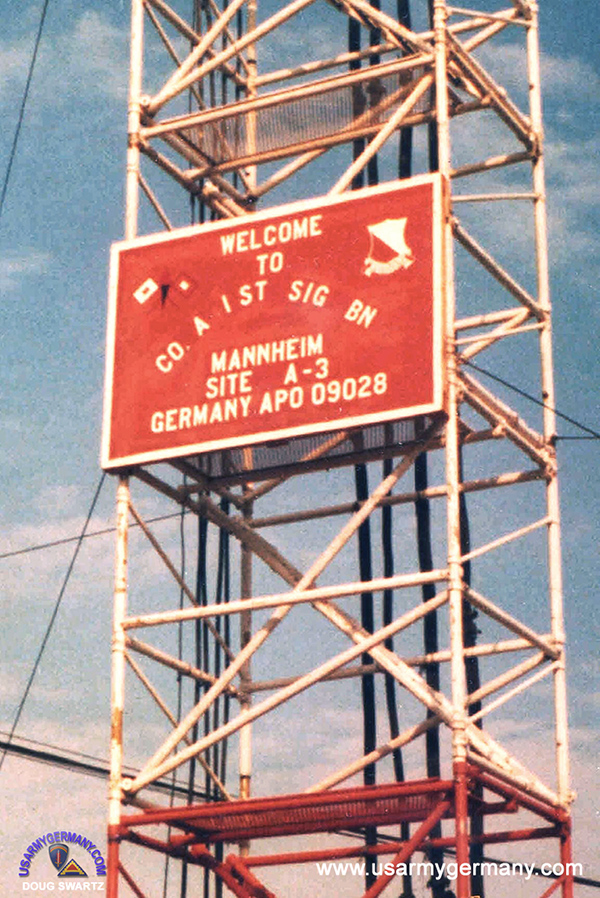 EDCN site A3 sign on 206' tall tower at Coleman Barracks, mid- 1970s (Doug Swartz) |
||||||||||||||||||||||||||||||||||||||||||||||||||||||||||||||||||||||||
| South Dakota Site (EDCN Site A3) | ||||||||||||||||||||||||||||||||||||||||||||||||||||||||||||||||||||||||
| (Source: Email from Chuck Webster) | ||||||||||||||||||||||||||||||||||||||||||||||||||||||||||||||||||||||||
| I have some photos from 73-74 from South Dakota Site, Mannheim-Sandhofen - part of the Emergency Deployment Communication Network (EDCN) network. Chuck Webster, SCPO, US Coast Guard (Ret) - I was in the Army first, just to avoid any confusion! |
||||||||||||||||||||||||||||||||||||||||||||||||||||||||||||||||||||||||
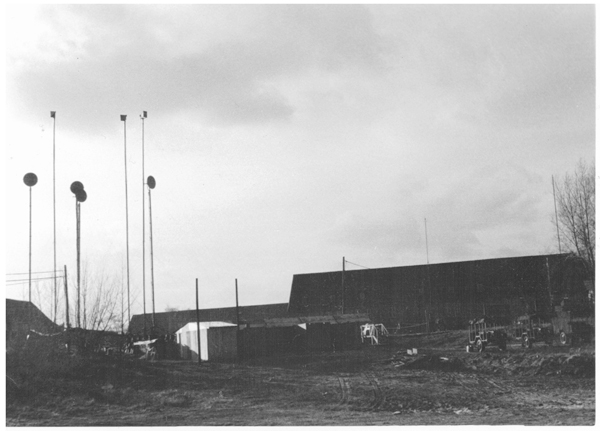 EDCN site A3 before construction of the antenna tower, 1973 |
||||||||||||||||||||||||||||||||||||||||||||||||||||||||||||||||||||||||
|
||||||||||||||||||||||||||||||||||||||||||||||||||||||||||||||||||||||||
| MISCELLANEOUS INFORMATION I am looking for information on the EDCN (Emergency Deployment Communications Network) Sites operated by 1st Signal Bn (1970s-80s). Please contact me |
||||||||||||||||||||||||||||||||||||||||||||||||||||||||||||||||||||||||
| Company "D" | ||||||||||||||||||||||||||||||||||||||||||||||||||||||||||||||||||||||||
| 1961 | ||||||||||||||||||||||||||||||||||||||||||||||||||||||||||||||||||||||||
| (Source: Email from Stephen Beeler, Co "D", 1961-63) | ||||||||||||||||||||||||||||||||||||||||||||||||||||||||||||||||||||||||
| As a green 2nd lt. I was the first telephone carrier officer in Co. D. of the 1st. Signal Bn. when it was activated in Oct. 1961.
Brief bio: I went thru ROTC at Indiana University which then taught only general military science in ROTC. I was assigned to the Signal Corps just before being commissioned because the assigning officer noted I had worked for the telephone company one summer in college. The only reason I had worked for the telephone company (in a non-technical job) was because my father was an executive there. In short, I did not know (and still do not know) a watt for an ohm when I went to Basic Signal Officer's training at Ft. Monmouth in July, 1961. Upon graduation (as a liberal arts major I graduated well behind my classmates with engineering degrees), I, along with all of my classmates and thousands of other U.S. Army personnel were shipped to Germany because East Germany had erected the Berlin wall in August and the Soviet Union was rapidly expanding its presence in Eastern Europe. I still remember the car ride from Rhine Main Air Base to Panzer Kaserne along with two other new 2nd Lts. I was awed by: (a) the autobahn (the US interstate highway system had not yet reached Indiana); (b) The immense pine forests; and (c) The picturesque German cities, towns, and villages which we passed. I spent the first night at the Boblingen Officer's Club at Panzer Kaserne which is quaint and overlooks a beautiful valley. I then reported as ordered to H.Q. 1st. Sig. Bn. along with the other new 2nd Lts. We were assigned to Cos. B, C, and D in the order that we stood before the Bn. Adjutant. Since I was last in line, I was assigned to Co. My understanding of events is that the 1st. Sig. Bn. was created in Oct. 1961 by breaking up the old 229th Sig. Co. which formerly supported 7th Army HQ. The most experienced personnel from the 229th were assigned first to Co. A of the 1st. Sig. Bn., then to Co B, and so on. As a result, my Co. D was the greenest. My first position was that of carrier platoon leader. Later I became the Signal Center Platoon Leader. I believe all companies of the 1st Sig. Bn. spent as much time in the field as in garrison during the period from Oct. 1961 to May 1963 while I was there. The 1st Sig. Bn. was in support of the 7th Army which under constant threat of attack from the East. The Cold War was at it high point and the Soviet Union presented a constant threat. However, while on active duty in Germany, I was able to take leave and travel throughout Europe and Great Britain. In fact, I took more leave than I accrued so that when I was released from active duty, the Army withheld funds from my final active duty pay. The 1st Sig Bn was part of the 505th Signal Gp. which was also located at Böblingen. I wore the 1st Sig Bn insignia. |
||||||||||||||||||||||||||||||||||||||||||||||||||||||||||||||||||||||||
| Related Links: 1st Circus/1st Signal Battalion - great site dedicated to 1st Signal Bn and Kaiserslautern. |
||||||||||||||||||||||||||||||||||||||||||||||||||||||||||||||||||||||||
